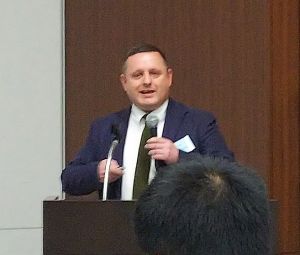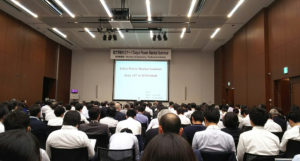Download Area
Welcome to the Download Area, where you can access all your downloads and updates. We hope you find what you are looking for.
Welcome to the Download Area, where you can access all your downloads and updates. We hope you find what you are looking for.
A path towards the future basis of energy supply
Post by Mark Coyle, Chief Strategy Officer @ mark.coyle@utiligroup.com

We have recently been engaging in the Japanese energy market with our colleagues at ESG leading to a speech I gave at their government METI Tokyo Power Market Seminar on 14th June 2018. Japan was liberalised two years ago and is experiencing fast evolution of their competitive market with new wholesale market services being introduced to support its development. What took the UK twenty years, will take only five in Japan and we will experience the digital age of energy together. There is much we can learn from each other, the path of energy is consistent across the world but the way it is achieved and timing will be local to each country. Japan is now the largest single energy market in the world and is experiencing global interest in participating there. We are pleased to contribute to its development and provide our value to the emerging competitive market leaders there. These may be domestic existing participants, new entrants or technology innovators who change the basis of energy Supply itself.

There are now six waves of energy change emerging in global markets, from competitive choice and the green transition through smarter then inter connected energy systems towards real-time flexibility and self-optimising autonomous energy systems. Key trends that emerge not one after the other but in a messy, overlapping way that makes choosing the right path complex for everyone. Competitive energy market maturity and green energy transition are already well underway and changing the basis of supply for consumers in the last two decades. Green energy is becoming the ‘new normal’, expected at the same price as carbon based sources and experiencing declining cost curves with scale adoption that make this possible. The work by Bloomberg and others show this and we recommend reading the new Bloomberg Energy Report for 2018 which shows this accelerating trend

For end consumers, technology is already changing the way in which we purchase and engage in our goods and services. From the internet and mobile applications through to connected speakers and social media, technology is the leading way in which we explore the choices, benefits and best pricing available to us. We all now act proactively to navigate our way through the options, compare and make an informed choice. Sectors such as shops, holidays, insurance, media and consumer goods are changing quickly through online providers without any government or regulatory stimulus. The original incumbent brands are revitalising for the future or new digital first providers are disrupting them.
Global governments designed our global energy markets back in the eighties and early nineties, reflecting the unbundling of an integrated sector into new roles. These roles are consistent and still in place in all leading markets, with only the extent of unbundling really creating any difference in the role of energy retailer. The energy Retailer role stretched forward to meet the needs of this first internet age, which was all about the power to choose provider. Choice was the defining goal of governments in competitive energy markets. At first, this was through fixed line phone calls, letters and selling where people congregate such as shopping centres. Over time, this transitioned to include price comparison websites, brokers and email. The energy Retailer role went online but was mostly the same in pricing and service delivery. This may not be sustainable in the next era where the role of energy Retailer itself will change with further technology waves.
From empowering choice, the energy competitive model evolves to be all about leveraging the benefits of ‘smart’ devices for the customer. Across the world technologies deployments of smart meters, sensors, real-time energy monitors through to in-premise energy production are in delivery. These devices offer the first forms of connecting the customer and service providers in real time, which potentially transforms the experience between them. However, with more data about consumption and in-premise production, it also introduces the opportunity for innovative tariffs that evolve with the market or grid needs. Energy Retailers start to transition from a traditional utility provider basis towards becoming a technology enabled data insight service that focuses on how to deliver consumer benefit continually. This allows new providers who are expert in how to create benefits from those technologies to enter the sector ahead of a growing opportunity that they feel best placed to deliver.
Connecting individual devices to the energy service is the start of a wider next shift towards pervasive ‘connectivity’ across homes, businesses, markets, grids and service providers. Homes are becoming increasingly connected already, as are the services that provide the energy to them. Secure connectivity across and within these individual locations enables the integration of devices and locations on a distributed basis. This enables the full integration of renewable generation at consumer level and across communities, rather than just providing export into the primary grid. New expert providers can aggregate and start to optimise the individual distributed devices to create new mutually beneficial services between the consumer and energy system in real-time. Our society is just at the start of this phase, with some customers and many providers looking forward toward the new opportunity. As our society transitions towards electric vehicles, they become an integrated part of the connected energy era in combination with energy storage and the smart meters.
The integration of these distributed connected technologies enables a fourth phase for energy competition, where the focus evolves from visualising and personalising energy to optimise it for the consumer. This is an era of energy ‘flexibility’ where our devices are connected and can use energy in a way that benefits our society, reducing system stress and receiving associated financial reward. Leading competitive providers will focus on automating our energy in a way that does not inconvenience us to deliver the right experience at the lowest overall cost. This requires trust and expertise in secure technology by the new energy Retailers of the time. At a point in our future, once the technology and optimisation is in place at scale, our energy systems will automate how to achieve the right integrated benefits for all using artificial intelligence in the ‘autonomous’ era.
Transport is already creating this phase even before it has transitioned towards full electrification. If humans can envisage a new technology, we feel the need to start building it. This is true for our energy markets where competition is no longer evolving incrementally, but is now about waves of overlapping innovation. Today, competitive energy is evolving to meet the needs of our first internet age, soon it will seem as though all the waves outlined here are happening at once. The opportunity and challenge for energy Retailers is to pick their path and customer focus areas through all this change. Moving quickly allows time for experimentation to establish customer engagement with the right digital first culture. In every sector, new digital providers are replacing the traditional incumbents. While existing providers have customers today, these new providers have a clean slate and a digital first culture that may attract the customers to them.

Creating the automated, integrated technology enabled service eco-system that liberates energy Retailers to innovate continually is vital. At ESG, we’re here to remove the industry complexity and enable operational customer excellence, so that your Retail business focuses on the customer. We enable participation and share insights across the leading competitive energy markets globally. Working together, we will enable your business to start delivering future customer benefits today.


A video stream will be made available soon of all event speeches and panel sessions by METI in Japan.
The presentation slides used at the Tokyo Power Market Seminar are available in PDF on request by email at mark.coyle@utiligroup.com
More about Japanese wave art is available to read at https://en.wikipedia.org/wiki/The_Great_Wave_off_Kanagawa
The images shown are out of copyright and included with respect and appreciation through the commons use licence.
| Release version | Release Date | Version details |
|---|